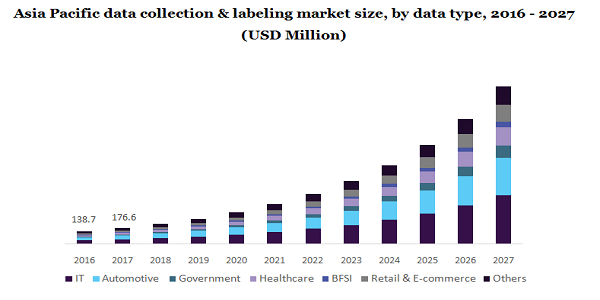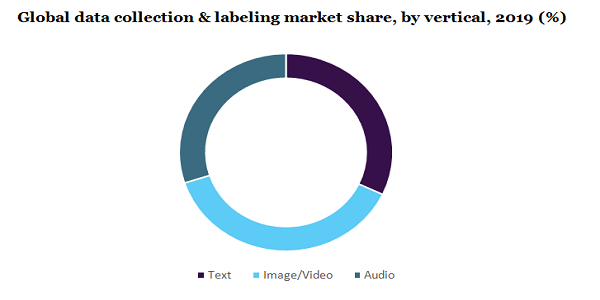- US: +1-408-610-2300
- Toll Free: +1-866-831-4085
- Become a Client
The global data collection & labeling market size was accounted for USD 1.0 billion in 2019 and expected to grow with a CAGR of 26.0% during the forecast period, from 2020 to 2027. The demand for data collection and labeling is projected to increase due to its several benefits such as accessing business insights through socially shared pictures as well as an auto-organizing untagged photo collection. In addition, it helps to enhance the safety feature in automated vehicles including wear detection, terrain detection, condition monitoring, and emergency vehicle detection. Currently, machine learning is embedded in several devices such as drones and robotics, face recognition on social media sites, and automated image organization of visual websites. Social media monitoring is a key application in data collection, as visual analytics and visual listening are important factors in digital marketing. This technology is highly implemented in security and safety- applications. Face recognition is a key application of data collection used by law enforcement agencies among many other applications.
Several companies have taken initiatives to strengthen their machine learning model by outsourcing data collection and labeling services. For example, U.S. based company; Globalme Localization Inc. offered the accent and dialect collection to U.S.-based audio company, Sonos Inc. This company introduced smart home assistants with wireless speakers by gathering speech and accent data from three countries. This integration supports the company in enhancing its speech identification engines to offer a better voice experience.

Data collection & labeling is projected to play an important role in the healthcare sector, as medical imaging is used in computer vision technology to detect the disease and injuries. Data labeling also helps in differentiating the information gained from medical images including X-Ray, CT scan images, and Magnetic Resonance Imaging (MRI). Further, it helps physicians to examine the individuals. For example, TrainingData.io helps radiology customers to increase labeling efficiency by 10 times and reduces the chances of errors by over 15%. The company has designed a web platform to support the companies in managing their data collection flow.
With the emergence of cloud-based media services and an increasing number of mobile devices, various data processing technologies are introduced including data classification, data labeling, and multilingual speech transcription. However, data labeling inaccuracy is expected to be a challenge for market growth. For example, images with low resolution are tough to label, this can lead to extra cost and effort for executing the process. Thus, to reduce the dependency on manual processes, manufactures are engaged in introducing automated tools. For example, Tagalog Sp. z o.o. offers a multipurpose data labeling tool to offer automated annotation.
Based on data types, the data collection & labeling market is fragmented into audio, image/video, and text. The image/video segment is expected to have robust growth over the forecast period owing to the rising application of computer vision in various industries such as automotive, media & entertainment, and other industries. For example, data labeling is widely used for medical imaging applications.
In 2019, the text segment held the largest market share due to increasing application in e-commerce and clinical research. Clinical data collection includes unstructured text documents is a key factor for clinical research due to the increasing application of Electronic Health Record (EHR) systems. Development in sentiment analysis, text labeling is majorly used to build recommendation systems in social media monitoring. For example, the e-commerce industry players widely used for social media data to encourage customers for purchasing.
Based on verticals, the market is bifurcated into automotive, IT, healthcare, e-commerce, BFSI, and retail. The healthcare segment is projected to grow during the forecast period, from 2020 to 2027. Since AI technology is used in the healthcare sector for numerous applications like treatment prediction, diagnostic automation, gene sequencing, drug development, and training of databases with machine learning and deep learning algorithms are needed. This scenario is expected to surge the market growth due to the rising demand for highly precise data labeling for well-organized AI-based applications.

The retail segment is projected to grow with a significant CAGR during the forecast period, from 2020 to 2027. Image labeling plays an important role in this sector, as online shoppers can search for products or clothing by getting a picture of print, texture, and color of their own choice. The photo clicked by smartphone is uploaded to an app to recommend similar products by using AI technology. Moreover, the data labeling technology is adopted in autonomous vehicles; thereby expected to boost the growth of the market in the automotive sector. Data collection & labeling enable automated cars to detect obstacles and inform the driver about the proximity to walkways. This technology also recognizes road signs and red stoplights.
In 2019, North America dominated the market owing to rapidly growing cloud media services, as media source is a potential source for data collection. In addition, increasing mobile computing platforms and the implementation of AI technology in e-commerce and digital shopping are other factors responsible for regional market growth. European data collection and labeling markets are projected to have considerable growth during the forecast period. Technological advancement in the automotive industry, by enabling this technology in automated vehicles is expected to boost the market growth in Europe over the next few years.
Asia Pacific is projected to grow with the fastest CAGR from 2020 to 2027. Factors like rapidly growing technological advancement, increasing penetration of tablets and smartphone users, and rising popularity of social networking sites in China and India are majorly responsible for the growth of the Asia Pacific market. In China, increasing the implementation of face recognition surveillance systems is expected to further propel market growth in the Asia Pacific. For example, the Chinese government has enforced citizens for real-name registration policies. In this policy, citizens have been required to link their online accounts along with official government ID, where these policies have used data collection and labeling across the nation.
In this pandemic situation, the market is observing significant growth across several industries, especially in the healthcare industry. Machine learning and artificial intelligence technologies are being extensively used in the healthcare sector to diagnose treatment prediction, diagnostic automation, drug development, gene sequencing, which is expected to drive the demand for data collection and labeling market in the outbreak of COVID-19. Machine learning and data analytics are going to play a really important role in understanding the spread of disease, as well as understanding the effectiveness of different responses to the disease.
Further, due to strict lockdowns across the globe, retailers have closed their shops, thereby the e-commerce industry is booming during this situation. The E-commerce industry is engaged in making it easier to find the product with the least effort for the consumers. In addition, visual representation is the most effective way to attract consumers. Product descriptions and images should match to avoid customer confusion. In this scenario, machine learning supports tag-specific product descriptions and keywords for images to check the quality of images simultaneously. Therefore, to strengthen machine learning technology, the demand for data collection and labeling is expected to increase in this situation.
The prominent players included in this market are Global Technology Solutions; Trilldata Technologies Pvt Ltd; Appen Limited; Alegion; Dobility, Inc.; Scale AI, Inc.; Labelbox, Inc; Playment Inc.; Reality AI; and Globalme Localization Inc.
Market players are focusing to increase their customer base to sustain a competitive market. Therefore, players are taking some initiatives such as mergers and acquisitions, collaborations, and partnerships with other vendors in the market. For example, in 2019, Uber Technologies Inc. acquired U.S.-based Mighty AI, Inc. to introduce computer vision models for self-driving cars. In the same year, Walmart Inc. acquired India-based NLP solution provider Trilldata Technologies Pvt. Ltd. to bring high domain experts in machine learning technology and for application development.
|
Attribute |
Details |
|
The base year for estimation |
2019 |
|
Historical data |
2016 - 2018 |
|
Forecast period |
2020 - 2027 |
|
Representation |
Revenue in USD Billion and CAGR from 2020 to 2027 |
|
Regional scope |
North America, Europe, Asia Pacific, South America, and MEA |
|
Country scope |
U.S., Canada, Mexico, Germany, U.K., France, China, Japan, India, and Brazil |
|
Report coverage |
Revenue forecast, company ranking, competitive landscape, growth factors, and trends |
|
15% free customization scope (equivalent to 5 analyst working days) |
If you need specific information that is not currently within the scope of the report, we will provide it to you as a part of the customization |
This report forecasts revenue growth at global, regional, and country levels and provides an analysis of the latest industry trends in each of the sub-segments from 2016 to 2027. For this study, Million Insight’s has segmented the global data collection and labeling market report based on data type, vertical, and region.
• Data Type Outlook (Revenue, USD Billion, 2016 - 2027)
• Text
• Image/Video
• Audio
• Vertical Outlook (Revenue, USD Billion, 2016 - 2027)
• IT
• Automotive
• Government
• Healthcare
• BFSI
• Retail & E-commerce
• Others
• Regional Outlook (Revenue, USD Billion, 2016 - 2027)
• North America
• U.S.
• Canada
• Mexico
• Europe
• Germany
• U.K.
• France
• The Asia Pacific
• China
• Japan
• India
• South America
• Brazil
• Middle East & Africa


Research Support Specialist, USA